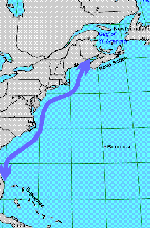 |
 |
 |
 |
 |
 |
 |
Right Whale Migration Update: April 26, 2000
Today's Report Includes:
- Greetings from the Stellwagen Bank National Marine Sanctuary
- Whales Looking for Some Good Food
- Migration Distances for Mother and Calf Pairs, CQ #13
- Rotund Right Whales
- Challenge Question #14
- How Much Food in a Day? Challenge Question #15
- Discussion of Challenge Question #11
- Discussion of Challenge Question #12
Greetings from the Stellwagen Bank National Marine Sanctuary.
As I noted in the humpback whale report, the weather here in Massachusetts (and along much of the East Coast) has been wet and wild over the past couple of weeks, making travel by boat or plane quite difficult. Very few patrols have been attempted due to high winds and rough seas. The last good day of sightings was April 7th when 32 whales were seen throughout Cape Cod Bay. The last recorded sighting was on April 15th by a whalewatching vessel out of Provincetown, Rhode Island.
Whales Looking for Some Good Food
In past years at about this time of the year the whales move out of Cape Cod Bay and begin to feed on zooplankton patches in the Great South Channel, a passage between Georges Bank and Cape Cod/Nantucket area. Due to the lack of patrols, we do not know if this pattern is holding.
Migration Distances for Mother and Calf Pairs
 |
Challenge Question #13:
"How great is the distance the one mother-calf pair would have to travel between South Carolina and the Gulf of Maine/Great South Channel?(Use Nantucket Island as a reference point). Measure using a mileage program or any other creative measuring system, then calculate nautical miles."
(Hint: 1 nautical mile = 1.15 statute miles, and 1 kilometer = 0.621 statute mile = 0.540 nautical mile.)
(To respond to this please follow the instructions
below.)
Rotund Right Whales
 |
Challenge Question #14:
"How many pounds is that? What weighs the same as a right whale? (How many elephants?) How much does the right whale's blubber weigh?"
(To respond to this please follow the instructions below.)
How Much Food in a Day?
It is often said that blue whales can eat a single meal of two tons or more of krill. Right whales may be eating up to a ton of food a day and humpbacks are probably consuming 1,500 pounds of sand lance and other small schooling fish. Since right whales are eating tiny copepods, 4,000 of which may fit in a teaspoon, that's a lot of animals. The larger the whale, the more food it needs.
Challenge Question #15:
"What percent of the total weight of a whale does a whale eat each day? How much would you need to eat each day if you were eating as much as a whale?"
(To respond to this please follow the instructions below.)
Hopefully, by my next report, we'll have some interesting sightings and some decent weather. That's all for this report. This is Anne Smrcina, education coordinator of the Stellwagen Bank National Marine Sanctuary, signing off.
Discussion of Challenge Question #11
"If you were a scientist, what would you do to find the missing whales?"
Margaret at the Ashley Academy, in Mrs. Patterson's Class replied:
"If I were a scientist I would search for them using some type of radar."
Emily, Peter, and Nick of Pemetic Elementary School, Southwest Harbor, Maine, wrote:
"We think scientists should take a bunch of rowboats (because they are a lot quieter than motor boats and won't scare the whales as easily) and circle in a different place near the regular feeding or calving grounds."
Melanie had a creative solution, as well:
"I would look for them by sending out sounds under water that sound like other whales. I would try to get them to come to me for a head count. I would use helicopters also to fly over waters where we think they are. You can see them from above and count them."
Thank you for your ideas. Scientists are doing their best to learn more about these whales' habits and habitats.
Discussion of Challenge Question #12
Our studies of migration lead us to maps of all kinds. In this question you were asked to study a map of the ocean floor and think about some questions you might ask about whales and their habitat. Here are some questions you submitted:
"Dear Journey North,
We came up with 3 questions:
1. Why do right whales pick the spot off Nova Scotia instead of somewhere else?
2. Why don't the right whales migrate farther up north?
3. Why do they migrate North and South instead of East and West?
Sincerely,
Emily, Peter, and Nick, Pemetic School, Southwest Harbor, Maine"
How to Respond to Today's Right Whale Challenge Questions:
1. Address an E-mail message to: jn-challenge-rwhale@learner.org
2. IMPORTANT: In the Subject Line of your message write: Challenge Question #13 ( or #14 or #15).
3. In the body of the your message, answer the question above.
The Next Right Whale Migration Update will Be Posted on May 10, 2000.
Copyright 2000 Journey North. All Rights Reserved. Please send all questions, comments, and suggestions to our feedback form
 |
 |
 |
 |
 |
 |
